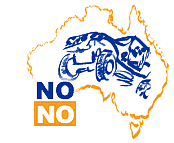 expeditionsaustralia.com
expeditionsaustralia.comIf you wake up early and take the Jump Up Loop Walk, you have a good chance of observing an array of animals in their natural habitat. Euros – stocky, dark grey coated kangaroos, red kangaroos, birds, lizards (including Sand Monitors, Bearded Dragons and Shinglebacks) and snakes.
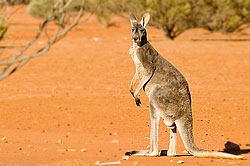
Our first item on the agenda for the day is to cross the Sturt National Park. We chose the Middle Road track and we were not disappointed. The scenery over some 100 kilometres of the arid rangelands littered with animal bones was unreal. We passed a number of no longer used sheep paddocks and man-made watering points. The landscape in this area is not monotonous, the constantly changing colours, and the kangaroos that can await you around every corner made for a very entertaining drive.
A few times we drove alongside the dingo proof fence that follows the state border. The world’s longest, this fence was originally built to stop the proliferation of rabbits introduced to Australia in the middle of the 19th century for the purposes of hunting. The rabbits adapted much too well and spread with alarming speed, damaging grazing fields and devastating crops.
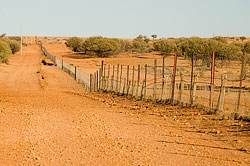
The fence didn’t fare very well at stopping the rabbits, however it proved to be useful for keeping dingoes, notorious for killing animal stock, out of New South Wales from neighbouring Queensland and South Australia. In the Corner Country, where we are now, the fence is maintained by the Wild Dog Destruction Board and signs warning of $1000 fines remind those travelling through, that the penalty for not closing the gates is a serious affair. Further east the fence is used to break the migration patterns of emus.
You may be curious about what happened to all the rabbits. Well, in the 1950’s a species specific, specially developed Myxoma Virus was introduced into the rabbit population. Over the years as the virus lost its effect. Different attempts at reintroducing it, using various kinds of fleas as vectors (for delivering the virus to rabbits) were performed. In 1995 a new kind of virus, called Calicivirus was used. It worked for some time effectively reducing rabbit numbers, but the population has started recovering again. So, this is still an ongoing battle. New measures such as immunocontraceptives are being developed, as well as traditional control techniques still being used. Land owners are legally bound to control rabbits and eradication campaigns are a popular pastime in rural areas.
We crossed the Dingo Fence at Cameron Corner, a location named after the NSW Lands Department surveyor, John Brewer Cameron. Cameron Corner is where three Australian states: New South Whales; Queensland and South Australia meet, this is practically the middle of nowhere, just like many other places in the Australian outback.
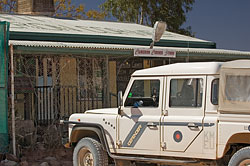
There is one store, and we went there hoping to buy some frozen cow juice. The entire ice-cream supply was sold out and the next delivery was a couple of days away, but the friendly attendant gave us a taste of her freshly baked Anzac cookies, which in Australia are called biscuits.
We were sitting in the air-conditioned bar drinking cold ginger beer, eating cookies, listening to the attendant telling us how she would be going to California to the tough neighbourhoods of LA, and how she was looking forward to making difference in kids’ lives by educating then about breaking the circle of poverty and violence… Then we noticed that the ceiling of the room was plastered with five dollar bills. We had to learn what this was all about.
The money pinned to the ceiling is donations to the Royal Flying Doctor Service. But how they get there is mighty interesting. The process requires a bill, a thumbtack and a 20 cent coin. First, the thumb tack is pushed through the middle of the bill. Then the coin is placed flat against the thumb part of the thumbtack, and the bill is wrapped tightly around the coin. The resulting contraption is that of a crude dart: throw it up, and if you are lucky it will lodge to the ceiling; the bill slowly unwraps releasing the coin, and it falls to the floor. If you catch the falling coin, you keep it; otherwise it goes to the donation jar. A funny thing happened when we tried the procedure using American paper money (Australian bills are made out of plastic). After getting pinned to the ceiling the bill would not unwrap, and held on to the coin. This presented a safety hazard, as we did not want somebody to get hit in the head by a falling coin that might have decided that it had enough of the ceiling time, so one of us had to get up on a chair and release the 20 cent Australian coin from the grips of the American bill.
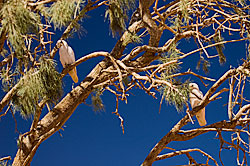
We spent some more time in the Cameron Corner Store, chatting, reading and signing the guestbook, and then it was time to head for Innamincka some 240 kilometres away. This constituted the beginning of the South Australian leg of our journey. If you are ever out that way, near Bollards Lagoon, watch for the abandoned yellow double-decker bus near an old windmill; we spotted a couple of cockatoos there, sitting in the branches of a lonesome tree waiting over the hot part of the day.
This is dune country, and the ups and downs of the road resembled a roller coaster ride. Of all the inland areas in Australia we passed on our trip, this is where the on-board GPS unit registered the lowest altitude – 25 meters on the road past Dunjeroo Waterhole.
At Merty Merty we joined the Old Strzelecki Track. Named after Polish explorer and philanthropist Pawel Edmund de Strzelecki, the track runs north through an oil and natural gas rich area where pumps are hard at work, and then on into the Innamincka National Reserve finally ending at Innamincka.
For lunch we stopped on the side of the road. Curiously the place was littered with old footwear. Attacked by swarms of flies we did not investigate, but hurried to finish our food and got back on the road featuring roadtrains and dust devil Willie-Willies to arrive in Innamincka, a town with a population of 14 and brown water.
We purchased our camping permit, and went to find a good spot on the banks of Cooper Creek at Cullyamurra Waterhole.
Copyright © 2005 - 2016 NoNo Expeditions Australia, Limited. All rights reserved.